NIF & PS People - 2017
September
Summer Scholar’s Robots Lead the Way to STEM Careers
Sparking Girls’ Interest in STEM Careers
Albert, Casner Receive 2017 Edouard Fabre Prize
NIF & Photon Science physicist Félicie Albert has been awarded the 2017 Edouard Fabre Prize for her contributions to the physics of laser-driven inertial confinement fusion (ICF) and laser-produced plasmas. Albert shares this year’s award with frequent NIF collaborator Alexis Casner, research director of the French Alternative Energies and Atomic Energy Commission (CEA). 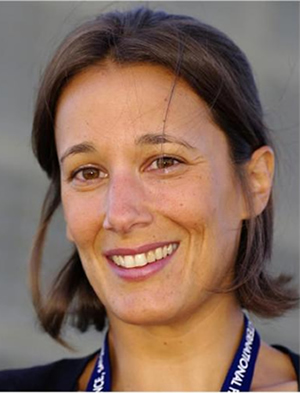 Félicie Albert
Félicie Albert
Albert is the second NIF&PS physicist to receive the Fabre Prize in the last three years; Pierre Michel was honored in 2015 for his pioneering research into energy transfer between crossing laser beams in NIF hohlraums. NIF collaborator Gianluca Gregori of the UK’s Oxford University received the prize in 2014.
The Edouard Fabre prize, named for one of the founders of ICF in Europe, is awarded to active researchers within 15 years of their doctoral degree. Sponsored by the European Cooperation in Science and Technology (COST) Network for Inertial Confinement Fusion, the award was presented during the 10th International Conference on Inertial Fusion Sciences and Applications (IFSA 2017), held in Saint-Malo, France, on September 11-15. Also presented at IFSA was the 2017 Edward Teller Award to Paul Drake of the University of Michigan, still another frequent NIF collaborator.
The Fabre Prize is the second award of the year for Albert, an expert in ultrafast x-ray sources and laser-plasma interactions. Earlier this year she received the 2017 Katherine E. Weimer Award from the American Physical Society Division of Plasma Physics (DPP). She was recognized for “pioneering development and characterization of x-ray sources from laser-wakefield accelerators and Compton scattering gamma-ray sources for applications in high energy density science and nuclear resonance fluorescence.” That award will be presented during the DPP annual meeting the week of Oct. 23-27 in Wisconsin.
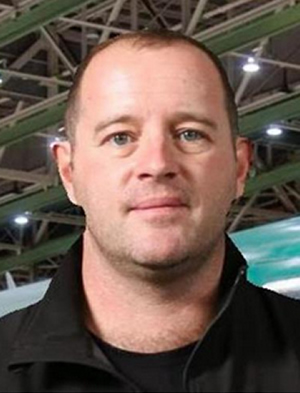 Alexis Casner
Alexis Casner Last year Albert was selected by the Department of Energy’s Office of Fusion Energy Sciences to receive funding as part of DOE‘s Early Career Research Program. She joined LLNL as a postdoctoral researcher in 2008 and became a permanent member of the scientific staff in 2010. She earned her PhD in physics from the Ecole Polytechnique in France in 2007 and her M.S. in optics from the University of Central Florida in 2004.
Along with his post as research director at CEA, Casner serves as deputy director of the Center for Intense Lasers and Applications (CELIA) at the University of Bordeaux in France. He has been principal investigator (PI) for experiments on NIF and the OMEGA Laser at the University of Rochester for the last 14 years, and has been PI for three NIF Discovery Science experiments. His chief ICF expertise is in hydrodynamic instabilities and x-ray imaging diagnostics.
Both Albert and Casner presented Edouard Fabre lectures at IFSA; they were among nearly 40 LLNL researchers presenting talks and posters at the conference. Albert’s plenary talk was titled, “Betatron x-ray radiation in the self-modulated laser wakefield acceleration regime: prospects for a novel probe at large scale laser facilities.” The title of Casner’s lecture was, “From ICF to Laboratory astrophysics experiments relevant to the physics of young Supernova Remnants: ablative and classical Rayleigh-Taylor Instability in turbulent-like regimes.”
The IFSA conferences are held every two years is to bring together scientists and engineers in the fields of inertial fusion sciences and high-energy-density physics, their applications, and all the required technologies. LLNL’s John Edwards, the ICF program director, was co-chair of this year’s conference.
Summer Scholar’s Robots Lead the Way to STEM Careers
Thanks to NIF & Photon Science Summer Scholar Kaavya Nimmakayala, robots programmed by local youths will be helping spark interest in STEM (science, technology, engineering, and math) careers for years to come.
With the inspiration and contributions of her local Girl Scout leaders and Livermore Lab volunteers, Nimmakayala developed a passion for robotics and spent half her school years building more than 25 of the bots. That effort culminated in Nimmakayala devoting the final summer after her high school graduation to running a community STEM project for children, while also working full time programming NIF target alignment software.
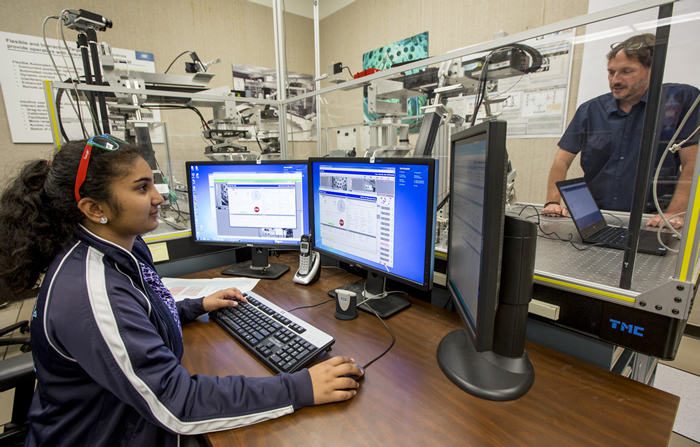 Kaavya Nimmakayala works on scripts for the NIF Target Alignment Assistant Tool under the guidance of Rick Wilson, Alignment Systems Integration lead. Credit: Jason Laurea
Kaavya Nimmakayala works on scripts for the NIF Target Alignment Assistant Tool under the guidance of Rick Wilson, Alignment Systems Integration lead. Credit: Jason Laurea “I thought it was important,” Nimmakayala said of her heavy volunteer commitment on top of her work schedule. “I wanted to give other kids what people had given to me, and I wanted to take advantage of opportunities offered to me.”
The seeds of Nimmakayala’s robotics success were planted at Livermore Lab.
A decade ago, a Girl Scout robotics program launched with a grant from the Laboratory and generous volunteer time from LLNL scientists and engineers established the troop focused solely on robotics, said current troop leader Melanie Young. And it was in that troop that Nimmakayala learned how to engineer all manner of droids and bots, including one that fights fires.
“I consider Kaavya one of our great success stories,” said physicist Dan Kalantar, a NIF&PS senior Target Area scientist. He has been one of Nimmakayala’s long-time mentors in Girl Scout robotics and the one who convinced her she had what it takes to become a NIF&PS summer intern despite her youth. While there’s no age limit for Summer Scholar positions, it’s rare for a high school student to earn one of the highly competitive 40 to 50 internships each summer.
Nimmakayala, now 18, has been accepted into the School of Engineering at Virginia Tech in Blacksburg and is entering as a freshman this academic year.
At NIF she worked with Alignment Operations Manager Shannon Ayers and Rick Wilson, Alignment Systems Integration lead, writing computer code for the facility’s Target Alignment Assistant Tool (TAAT) scripts that automate the steps for target, diagnostic, and laser beam alignments for Control Room operators.
Process Improvements
As her mentor working one-on-one with Nimmakayala, Ayers said she was impressed with how quickly she picked up the TAAT scripts code and the systems for the “Splunk” dashboard, which reads the data collected by a TAAT script during a NIF shot (Splunk Enterprise software is used to log and analyze data and to organize large quantities of data). Those data are used both for understanding the health of the alignment systems and for providing information to help guide process improvements.
“She has done a great job learning how both systems work and interface, and has delivered impactful products to the program that will help guide process improvements activities planned for the next year,” Ayers said.
When not working at the Lab, Nimmakayala’s summer was spent running a free robotics program at Owls Landing, a local affordable housing complex. The program was coordinated through Horizons Family Counseling for the Livermore Police Department and the city of Livermore Housing and Human Services Division. Her program drew nine children, most in the target age group (middle-schoolers), although to her surprise some elementary-school-aged children also stuck with the five-week program.
Both Nimmakayala and Horizons program manager Lynn Gardner hope her robotics program will be able to find funding to continue as a summer program for youths without access to STEM programs. Her project was aimed at earning the a Girl Scout Gold Award,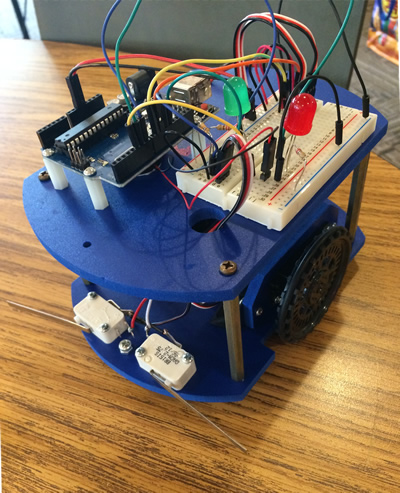 A robot built from one of Nimmakayala’s kits. the capstone of the scouting world that only some 5 percent of young women qualify for, by providing a project that benefits the community and is also sustainable.
A robot built from one of Nimmakayala’s kits. the capstone of the scouting world that only some 5 percent of young women qualify for, by providing a project that benefits the community and is also sustainable.
For the legacy requirement, Nimmakayala developed a curriculum designed to be plug-and-play. It includes ready-made robot kits costing about $50 and a manual for a five-week program enabling children to assemble a small robot, about the size of a bread loaf, and perform basic programming to run the bot.
Her program was funded by donations from her Girl Scout troops, Horizons/Livermore city programs, the Livermore Police Department, and the Alameda County Probation and Housing and Human Services departments. Gardner handled outreach to families in the complex while Nimmakayala recruited volunteers like Kalantar and trained others, including the Livermore outreach coordinator, on how to run an effective robotics program for beginners.
Gardner saw a positive outcome from both families and children, who were excited about what they were able to accomplish, she said. “Many of them felt it helped them to focus. I saw it in the way they talked about themselves—they could show they could program a robot. They felt they had done something physical with their hands.”
One of the challenges Gardner faces, even with free programs like summer robotics, is that children and families from non-traditional and lower socioeconomic backgrounds feel a lack of connection and decline to participate in educational enhancement programs and identify possible future careers. “We’re just trying to connect those pieces to help the family get a stronger foundation,” she said, “and programs like these are an important part of building that foundation.”
Rise of the Robots
Robotics became all the rage among high-achieving students in the 2000s, complete with travel competitions and subgroups focused on Lego robots, ozobots, androids, underwater robot challenges, and others. Nimmakayala caught the bot fever growing up in the Tri-Valley, but when she joined an after-school robotics program in middle school she quickly soured. “There was a tendency of the guys to take over,” she said, sometimes grabbing the robots and tools out of her hands.
She could have just moved on. She competed on her school’s swim and water polo teams and became active in the Model United Nations programs, with a passion for learning Japanese (she still swims daily; for fun, she loves the movies and hanging out with her beagle, Chip).
“We’re an important access point.”
—Melanie Young
But she was intrigued with robotics and didn’t want to quit. Her family found her a Girl Scout connection to robotics through Young’s troop, where she met Kalantar, whose own daughters were scouts. While they are now aged out of Robo-scouts, Kalantar continues to volunteer for Young’s troop because of girls like Nimmakayala, who gain so much through the program.
“I’ve seen girls walk in,” he said, “not ever having held a hammer, screwed in a wood screw, not knowing how to turn on a power tool, how to solder, the basics of circuits, resistors, oscilloscopes, computer programming, all those things on a basic level (that) go into mechanics.
“That’s what Kaavya learned in Girl Scouts,” he said, “and that’s the overview she was trying to give her own students through her robotics summer program—allowing them to see that this is a cool project and they could be the ones to actually assemble the robot and make it move.”
Through robotics, Scout leader Young’s own daughters also grew into confident technology-savvy women. The younger daughter is a junior at Massachusetts Institute of Technology, and her sister is a graduate of the Jacobs School of Engineering at the University of California-San Diego.
“One of the things we feel strongly about,” Young said, “is that, if you don’t get them in middle school, then you don’t have any girls (in STEM careers). “We’re an important access point.”
Sparking Girls’ Interest in STEM Careers
NIF engineering technician Destiny Goddu was the keynote speaker at the 2017 San Joaquin Expanding Your Horizons (SJEYH) Conference for girls on Saturday, Sept. 23. The conference celebrated its 25th year by bringing 500 girls to the University of the Pacific Campus in Stockton to learn more about science, technology, engineering and math, or STEM.
Co-sponsored by LLNL, Sandia National Laboratories, and the University of the Pacific School of Engineering and Computer Science, SJEYH is designed to spark young girls’ interest in STEM careers in a fun environment. Participants spanning grades 6 to 12 come from across San Joaquin and Stanislaus counties—from Stockton, Lodi, Manteca, and Modesto as well as rural communities—to attend the daylong event.
 Destiny Goddu encourages Expanding Your Horizons attendees to find and pursue their passion. Credit: LLLESA Photography Networking Group
Destiny Goddu encourages Expanding Your Horizons attendees to find and pursue their passion. Credit: LLLESA Photography Networking Group Goddu, a U.S. Marine Corps veteran who recently received her associate of science degree in engineering technology while working part-time at NIF, began her talk with a quote by actress Emma Watson: “Girls should never be afraid to be smart.”
Warming to the conference theme, "STEMpowered!", Goddu shared the off-again, on-again story of how she decided to pursue a career in STEM.
“It took me a long time to realize that I was capable of doing whatever I put my mind to, regardless of my gender,” Goddu said. “As a child I would help my father work on cars. Old engines and car parts filled my backyard growing up and sparked my interest in mechanics.”
It wasn’t a clear-cut journey for Goddu. She talked about losing her spark for academics in high school, being more concerned with popularity and being cool, until her senior year when a high school teacher told her she should be an electrician. “Although I didn’t pursue a career as an electrician after high school, that conversation with my high school teacher was a big part of why I chose the path of aviation electronics in the Marine Corps.”
Goddu served in the Marines for five years, a tenure that included many awards and medals for her service. As a female in the Marine Corps, Goddu felt she had to work twice as hard as the men to prove herself. “It’s not always easy being in a male-dominated field like the military, and there was a point that I allowed that to cause some resistance again for a career in STEM. I lost that spark again and allowed others to drain my battery.”
Veteran of the Year
After being honorably discharged, she enrolled in the Veterans to Technology program at Las Positas College. She interned at LLNL during her studies, performing so well she was asked to stay and work as a NIF mechanical engineering technician while pursuing her degree. In July, Assemblywoman Catharine Baker (R-San Ramon) recognized Goddu as the Veteran of the Year for her 16th Assembly District.
“My experience in STEM has been full of times that often felt like failures, but little did I know then that failure was part of success,” Goddu said. “Don’t be afraid to work hard, to find your passion and to see what you are capable of. Don’t let others hinder your path to greatness. Find out what sparks your interest by getting involved in more STEM programs like today and be sure to take advantage of all these wonderful mentors here that volunteered to be here for you. I hope today helps you find your passion and ignites your source of STEM power.”
At the conference, each participant attended three out of 21 available hands-on workshops and visited booths featuring various STEM activities. Giving demonstrations at the NIF & Photon Science booth were Kathleen Schaffers, Rebecca Dylla-Spears, Robin Miles, Henry Hui, and Alex Aguirre, who were among more than 40 LLNL employees involved in SJEYH.
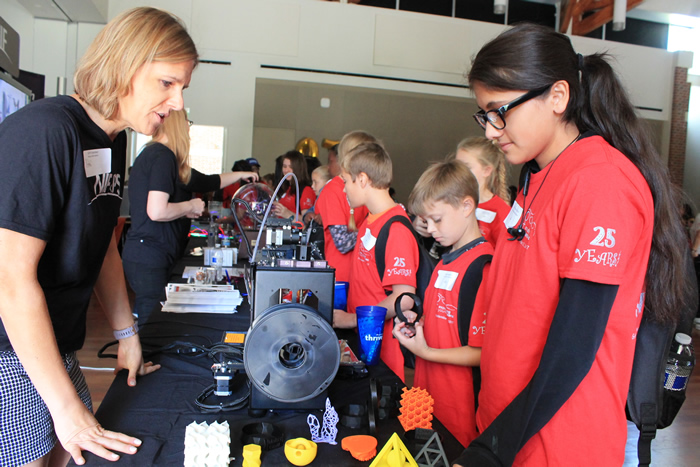 Rebecca Dylla-Spears demonstrates a 3D printing process and explains how such additive manufacturing technologies can benefit areas of interest to LLNL and NIF&PS. Targets and optics, for example, could be built with structures and compositions that can’t be made using other manufacturing techniques.
Rebecca Dylla-Spears demonstrates a 3D printing process and explains how such additive manufacturing technologies can benefit areas of interest to LLNL and NIF&PS. Targets and optics, for example, could be built with structures and compositions that can’t be made using other manufacturing techniques. Brookelyn McCaffrey, a seventh-grade student at Ben Holt Middle School, a “College for Certain” charter school in Stockton, attended the conference for the first time and described her experience as “awesome.”
“The thing I liked the most was learning about science experiments,” she said. “In one class, I learned about energy and how it can transfer through bodies, and I also liked learning about liquid nitrogen. It was so cool. I really love math and architecture and I want to be a civil engineer. I am excited for my future in science.”
Jeene Villanueva, an LLNL computer scientist, has served as SJEYH conference chair/co-chair since 2014. “It was a special year celebrating our 25th anniversary,” Villanueva said. “We continue to have amazing presenters who run inspiring workshops, chaperones who return year after year, volunteers to help anywhere they can and a dedicated SJEYH board core committee planning for several months behind the scenes. It is a rewarding experience to see the excitement on the faces of the attendees during the workshops and activities at EYH.”
SJEYH is one of two Expanding Your Horizons conferences coordinated by LLNL volunteers. The 2018 Tri-Valley Expanding Your Horizons Conference will be held Feb. 24 at the Diablo Valley College San Ramon Campus. For more information on this and other LLNL STEM activities, see “Laboratory Outreach Programs Inspire the Next Generation.”




